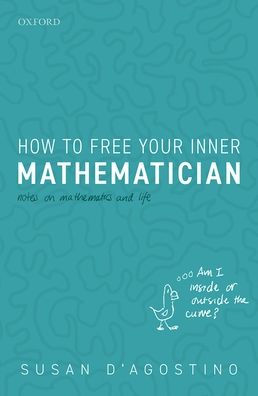5
1

How to Free Your Inner Mathematician: Notes on Mathematics and Life
368
by Susan D'Agostino
Susan D'Agostino

How to Free Your Inner Mathematician: Notes on Mathematics and Life
368
by Susan D'Agostino
Susan D'Agostino
Hardcover
$40.99
-
PICK UP IN STORECheck Availability at Nearby Stores
Available within 2 business hours
Related collections and offers
40.99
In Stock
Overview
How to Free Your Inner Mathematician: Notes on Mathematics and Life offers readers guidance in managing the fear, freedom, frustration, and joy that often accompany calls to think mathematically. With practical insight and years of award-winning mathematics teaching experience, D'Agostino offers more than 300 hand-drawn sketches alongside accessible descriptions of fractals, symmetry, fuzzy logic, knot theory, Penrose patterns, infinity, the Twin Prime Conjecture, Arrow's Impossibility Theorem, Fermat's Last Theorem, and other intriguing mathematical topics.
Readers are encouraged to embrace change, proceed at their own pace, mix up their routines, resist comparison, have faith, fail more often, look for beauty, exercise their imaginations, and define success for themselves.
Mathematics students and enthusiasts will learn advice for fostering courage on their journey regardless of age or mathematical background. How to Free Your Inner Mathematician delivers not only engaging mathematical content but provides reassurance that mathematical success has more to do with curiosity and drive than innate aptitude.
Readers are encouraged to embrace change, proceed at their own pace, mix up their routines, resist comparison, have faith, fail more often, look for beauty, exercise their imaginations, and define success for themselves.
Mathematics students and enthusiasts will learn advice for fostering courage on their journey regardless of age or mathematical background. How to Free Your Inner Mathematician delivers not only engaging mathematical content but provides reassurance that mathematical success has more to do with curiosity and drive than innate aptitude.

Product Details
| ISBN-13: | 9780198843597 |
|---|---|
| Publisher: | Oxford University Press |
| Publication date: | 05/26/2020 |
| Pages: | 368 |
| Product dimensions: | 7.80(w) x 5.20(h) x 1.00(d) |
About the Author
Susan D'Agostino, Council for the Advancement of Science Writing; Taylor/Blakeslee Fellow, Johns Hopkins University
Susan D'Agostino is a mathematician and writer whose essays have been published in Quanta Magazine, Scientific American, Financial Times, Nature, Undark, Times Higher Education, Chronicle of Higher Education, Math Horizons, Mathematics Teacher, and others. She earned her PhD in Mathematics from Dartmouth College, Master of Arts in Teaching Mathematics from Smith College, and BA in Anthropology from Bard College. She is a Council for the Advancement of Science Writing Taylor/Blakeslee Fellow at Johns Hopkins University. Her website is www.susandagostino.com and her Twitter handle is @susan_dagostino.
Susan D'Agostino is a mathematician and writer whose essays have been published in Quanta Magazine, Scientific American, Financial Times, Nature, Undark, Times Higher Education, Chronicle of Higher Education, Math Horizons, Mathematics Teacher, and others. She earned her PhD in Mathematics from Dartmouth College, Master of Arts in Teaching Mathematics from Smith College, and BA in Anthropology from Bard College. She is a Council for the Advancement of Science Writing Taylor/Blakeslee Fellow at Johns Hopkins University. Her website is www.susandagostino.com and her Twitter handle is @susan_dagostino.
Table of Contents
1. Mix up your routine, as cicadas with prime number cycles2. Grow in accessible directions, like Voronoi diagrams3. Rely on your reasoning abilities, because folded paper may reach the moon4. Define success for yourself, given Arrow's Impossibility Theorem5. Reach for the stars, just like Katherine Johnson6. Find the right match, as with binary numbers and computers7. Act natural, because of Benford's Law8. Resist comparison, because of chaos theory9. Look all around, as Archimedes did in life10. Walk through the problem, as on the Konigsborg bridges11. Untangle problems, with knot theory12. Consider all options, as the shortest path between two points is not always straight13. Look for beauty, because of Fibonacci numbers14. Divide and conquer, just like Riemann sums in calculus15. Embrace change, considering non-Euclidean geometry16. Pursue an easier approach, considering the Pigeonhole Principle17. Make an educated guess, like Kepler with his Sphere-packing Conjecture18. Proceed at your own pace, because of terminal velocity19. Pay attention to details, as Earth is an oblate spheroid20. Join the community, with Hilbert's 23 problems21. Search for like-minded math friends, because of the Twin Prime Conjecture22. Abandon perfectionism, because of the Hairy Ball Theorem23. Enjoy the pursuit, as Andrew Wiles did with Fermat's Last Theorem24. Design your own pattern, because of the Penrose Patterns25. Keep it simple whenever possible, since26. Change your perspective, with Viviani's Theorem27. Explore, on a Mobius strip28. Be contradictory, because of the infinitude of primes29. Cooperate when possible, because of game theory30. Consider the less-travelled path, because of the Jordan Curve Theorem31. Investigate, because of the golden rectangle32. Be okay with small steps, as the harmonic series grows without bound33. Work efficiently, like bacteriophages with icosahedral symmetry34. Find the right balance, as in coding theory35. Draw a picture, as in proofs without words36. Incorporate nuance, because of fuzzy logic37. Be grateful when solutions exist, because of Brouwer's Fixed Point Theorem38. Update your understanding, with Bayesian statistics39. Keep an open mind, because imaginary numbers exist40. Appreciate the process, by taking a random walk41. Fail more often, just like Albert Einstein did with42. Get disoriented, on a Klein bottle43. Go outside your realm of experience, on a hypercube44. Follow your curiosity, along a space-filling curve45. Exercise your imagination, with fractional dimensions46. Proceed with care, because some infinities are larger than othersFrom the B&N Reads Blog
Page 1 of
